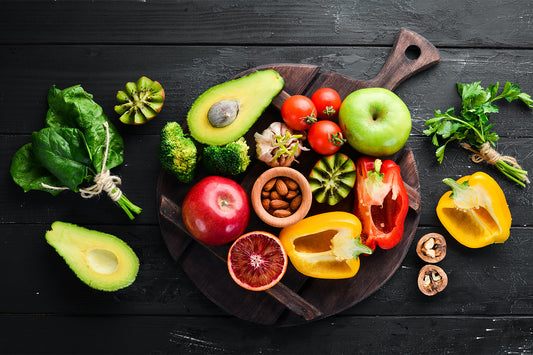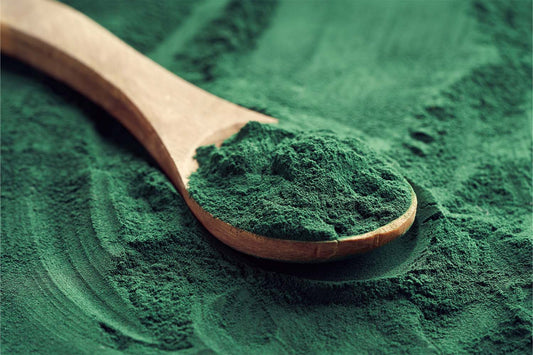As the pigment that gives salmon, shrimp, and even flamingos their distinctive pink hue, astaxanthin is more than just a natural food coloring. It's a potent antioxidant with a host of potential health benefits that can add a splash of wellness to your life.
Here at iwi life, we're all about harnessing the power of nature to enhance our health. We believe in the potential of plant-based nutrition and are committed to providing you with sustainable, nutrient-dense options. That's why we're excited to introduce you to astaxanthin, a naturally occurring compound found in certain algae and seafood.
What Is Astaxanthin?
Astaxanthin is a carotenoid, which is a type of pigment found in a variety of plants, algae, and certain kinds of seafood. Carotenoids are responsible for the vibrant colors you see in nature — the fiery red of a ripe tomato, the sun-kissed orange of a juicy carrot, and the rich pink of a salmon filet. However, astaxanthin isn't just a pretty face. It's also a powerful antioxidant.
In the simplest terms, antioxidants are substances that help protect your cells from damage. They do this by working to maintain and support your cell health during exposure to harmful molecules called free radicals, which can accumulate in your body due to factors like pollution, stress, and poor diet. Too many free radicals can lead to a state called oxidative stress, which has been linked to chronic health concerns.
Astaxanthin is often considered a "super-antioxidant" because it's thought to be significantly more potent than other carotenoids like beta-carotene and lycopene.
Why Is Astaxanthin Important for Your Health?
Astaxanthin plays a key role in maintaining and enhancing your health in a variety of different ways. Let's explore why astaxanthin is a must-have in your health and wellness toolkit:
- Eye Health: Astaxanthin is known for its ability to help maintain the health of the retina, the light-sensitive part of your eye. It may support overall eye health and help support healthy vision.
- Skin Health: Astaxanthin's antioxidant properties may help support your skin during exposure to UV radiation, which contributes to premature skin aging. Additionally, it can support proper skin elasticity and hydration, promoting a youthful and radiant appearance.
- Athletic Performance: For those leading an active lifestyle, astaxanthin can provide valuable support. It may help support muscle health and proper fat metabolism during exercise, contributing to endurance and recovery.
- Immune Function: Astaxanthin can be beneficial for your immune system by maintaining the proper activity of certain immune cells. This can contribute to optimal immune function, helping your body defend itself against illness.
- Brain Health: Astaxanthin can offer support for your brain by maintaining cognitive health, helping to keep your mind sharp and agile.
- Joint Health: Astaxanthin may offer support for joint health by supporting the body with a healthy inflammatory response.
What Are Some Astaxanthin-Rich Foods?
Astaxanthin is found in a number of foods, but it's particularly abundant in certain types of seafood and algae. Here's a detailed look at the top 20 astaxanthin-rich foods, listed from the richest to the least rich in astaxanthin:
1. Algae (Haematococcus Pluvialis)
This freshwater microalgae, often found in harsh environments where it produces astaxanthin as a survival mechanism, is the richest natural source of astaxanthin in the world. It contains around 40,000 mcg of astaxanthin per gram, a concentration that far exceeds that found in any other source.
2. Red Salmon Roe (Ikura)
As a caviar substitute, salmon roe is not only a luxurious choice but also nutrient-dense. It is packed with about 26,000 mcg of astaxanthin per 100 grams, making it a fantastic source of this potent antioxidant.
3. Arctic Shrimp
These cold-water shrimp, found in the icy waters of the Arctic, are a treasure trove of astaxanthin. They contain approximately 1,200 mcg of astaxanthin per 100 grams, providing a significant amount of this beneficial compound.
4. Sockeye Salmon
Known for its vibrant red flesh, wild-cooked sockeye salmon is rich in astaxanthin, containing around 26 to 38 mcg per gram. This makes it a great choice for those seeking to increase their intake of astaxanthin through diet.
5. Eel
Marine eels are astaxanthin-rich, with about 18 to 28 mcg per gram. This makes eel a highly beneficial food for those seeking to incorporate more astaxanthin into their diet.
6. Red Sea Bream
This fish, popular in Japanese cuisine, is not just delicious but also provides around 16 to 26 mcg of astaxanthin per gram. This makes it a healthy and tasty choice for astaxanthin intake.
7. Red Snapper
A favorite among seafood lovers, red snapper is not just known for its taste but also for its astaxanthin content. It has approximately 10 to 20 mcg of astaxanthin per gram.
8. Red Porgy
This Mediterranean fish is not only a delicacy but also offers about 8 to 18 mcg of astaxanthin per gram, adding to its nutritional value.
9. Red Seabream
Another astaxanthin-rich fish, red seabream contains around 6 to 16 mcg per gram, making it a good choice for those looking to increase their dietary intake of astaxanthin.
10. Red Drum
Also known as redfish, this species boasts about 4 to 14 mcg of astaxanthin per gram. This makes it a great addition to a diet focused on astaxanthin intake.
11. Red Rockfish
This variety of rockfish provides around 2 to 12 mcg of astaxanthin per gram, adding to its nutritional profile.
12. Red Grouper
This deep-sea fish, known for its firm texture and mild flavor, contains about 1 to 10 mcg of astaxanthin per gram, further enhancing its health benefits.
13. Red Perch
Known for its sweet taste, red perch not only offers a culinary delight but also provides around 0.5 to 8 mcg of astaxanthin per gram.
14. Red Mullet
A staple in Mediterranean cuisine, red mullet is not only flavorful but also provides about 0.4 to 6 mcg of astaxanthin per gram.
15. Rainbow Trout
This freshwater fish, known for its delicate flavor, is another good source of astaxanthin, yielding about 0.3 to 4 mcg per gram.
16. Trout
Similar to rainbow trout, this fish provides around 0.2 to 3 mcg of astaxanthin per gram, adding to its nutritional value.
17. Shrimp
This popular seafood is not only a culinary favorite but also contains about 1 to 2 mcg of astaxanthin per gram, making it a good source of this antioxidant.
18. Lobster
Marine crustaceans like lobsters offer around 0.5 to 1 mcg of astaxanthin per gram, adding to their nutritional profile.
19. Crawfish
These small crustaceans, often used in Southern cuisine, contain about 0.4 to 0.8 mcg of astaxanthin per gram.
20. Crab
Similar to lobsters, crabs also have astaxanthin but in lesser amounts, containing about 0.2 to 0.6 mcg per gram. Despite the lower amounts, they still contribute to the overall dietary intake of astaxanthin.
How Else Can You Get More Astaxanthin in Your Daily Life?
Astaxanthin is surely a nutrient that you'll want to weave into your daily life. But how can you increase your intake without overloading on seafood? Enter iwi life Vegikrill supplement — a sustainable, plant-based solution that's not only provides astaxanthin but also more easily absorbed by the body than traditional krill oil.
When krill oil first made waves in the nutritional world, it was hailed for its higher absorption rates than fish oil and its astaxanthin content. However, as we've come to understand more about the crucial role krill play in our environment, their harvest has come under scrutiny.
Antarctic krill, in particular, are vital in capturing about 12 billion tons of carbon from the atmosphere each year. Even with sustainable harvesting practices, we're still unsure of the environmental impact.
This is where iwi life shines. We have harnessed the power of sustainably farmed algae to produce omega-3 that's even more absorbable than what you find in krill oil. Our Vegikrill supplement not only provides this potent omega-3, but it also boasts a higher astaxanthin content than what naturally occurs in krill oil.
What's more, all of this comes from our plant-based algae, which is grown sustainably in desert pond beds, far from the ocean, using salt water from underground aquifers. This means we're keeping krill in the ocean, where they can continue playing their vital role in our ecosystem.
With iwi life's Vegikrill supplement, you're not only fueling your body with the highly absorbable omega-3 and antioxidant-rich astaxanthin, but you're also making a choice that supports the health of our planet. It's a win-win for your health and our environment.
The Bottom Line
In the world of wellness and nutrition, astaxanthin is a standout star. This potent carotenoid, with its powerful antioxidant properties, plays a crucial role in supporting various aspects of health.
Astaxanthin-rich foods, particularly certain types of seafood and algae, offer a natural way to incorporate this beneficial compound into your diet. Eating a variety of these foods can help to ensure you're getting a good dose of astaxanthin along with other essential nutrients.
However, given the challenges of environmental sustainability and the need to maintain a balanced diet, it might not always be feasible to rely solely on food sources for your astaxanthin intake. iwi life's Vegikrill supplement is a plant-based, sustainable option that provides both plant-based omega-3 and astaxanthin. It's an easy way to boost your astaxanthin intake and support your journey toward optimal health, all while making a positive impact on the environment.
Sources:
Carotenoids as Natural Functional Pigments | PMC
Antioxidants: Positive or Negative Actors? | PMC
Astaxanthin: A Super Antioxidant From Microalgae and its Therapeutic Potential | PMC
Astaxanthin in Skin Health, Repair, and Disease: A Comprehensive Review | PMC
Astaxanthin in Exercise Metabolism, Performance and Recovery: A Review | PMC
Antarctic Krill Play Significant Role in Carbon Capture, New Study Finds | Oceanographic
The Role of Astaxanthin as a Nutraceutical in Health and Age-Related Conditions | PMC


















